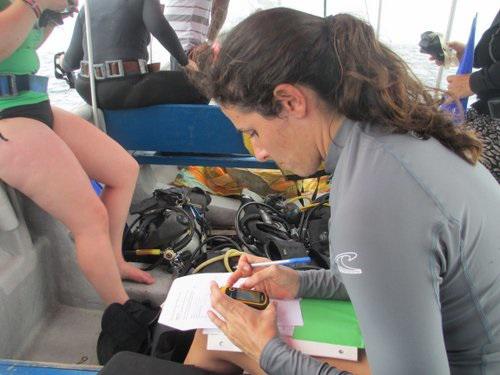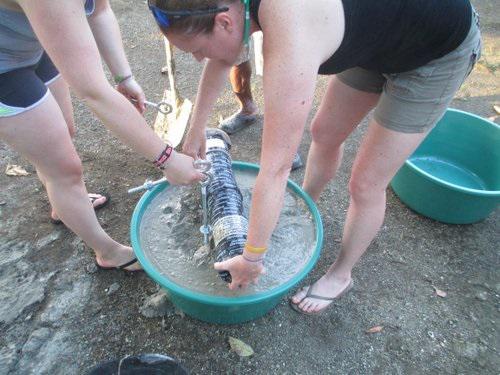Valeria Elena Gonzalez Borasca
The proposed construction of a marine port within the Gulf of Tribugá, Colombian Pacific, is set to begin as early as 2019, and will add considerably more human-generated noise to the ocean than there is now. These noises will be from both construction (e.g. pile driving) and more and larger vessels using the port. This noise will likely affect the marine ecosystem, including the endangered stock of humpback whales that breeds in the Gulf.
Documenting what the sound environment is this year compared to what it will become later will help with understanding how the humpback whales sing and call in both situations. In this way we will be able to determine if the whales change their communication strategies in the presence of increased noise, and track the effects of noise changes to its ambient environment over time.

Valeria marking a WP in the GPS. © Liliana Arango Mesa.
Humpback whales annually migrate between feeding and breeding areas. Specifically, Stock G uses the waters of the Colombian Pacific, and specifically the Gulf of Tribugà, to mate and calve between June and October of each year. The acoustic communication system of the humpback whale relies on an individual’s ability to establish and maintain contact with conspecifics across vast and proximate distances. Noise from industrial, commercial, and tourism activities that support the livelihood of local communities in the Gulf of Tribugá could mask critical communications for whales to find, mate with, and protect one another.

Kerri and Christina measuring where the hydrophone should remain over the cement. © Valeria González
This project is a replication of Dr. Seger`s 2016 dissertation research in Baja California, Mexico, to map the soundscape in an effort to track the influence of biotic and abiotic acoustic levels. To obtain acoustic data, two battery-operated Ecological Acoustic Recorders (EARs) using HTI-96-MIN (High Tech Inc.) hydrophones with -171 dB re 1V/Pa sensitivity, have been deployed in two areas of the Gulf of Tribugá: one in Nuquí, which represents an area exposed to noise pollution from fishing and tourism boats, and the other in Morro Mico, which represents a more pristine acoustic environment with little anthropogenic noise. The EARs will remain underwater from mid-July to mid-September 2018. Once the hydrophones are recovered, acoustic data will be processed using an in-house Matlab GUI written by Drs. Aaron Thode, Jit Sarkar, and Kerri Seger. Power spectral densities (PSDs) will be computed in dB re 1 μPa2/Hz and estimated to 3-Hz resolution each minute, by averaging FFT snapshots (overlapped 50%) over one minute intervals. This will result in an acoustical mapping of physical, biological, and anthropogenic activity in areas that are known to be more or less frequented by humans and humpback whales. More specific details about the GUI and digital signal processing can be found in Seger et al. (2016).
The results obtained in this study will be used as a Before-After Control-Impact (BACI) marine study. The two EAR deployment locations in 2018 will represent the “before / control” portion of the study. Subsequent years of data collection will be used to assess any changes to both anthropogenic and biologic sounds, especially those of humpback whales, as the “after / impact” portion.